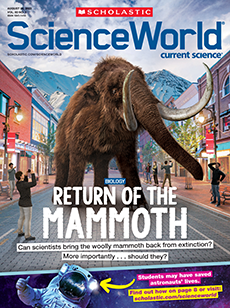On the island of Madagascar off the east coast of Africa, ring-tailed lemurs leap through the forest treetops, pausing to groom one another or munch on juicy fruits. After decades of being hunted and having their habitat destroyed, these animals are now in danger of becoming extinct. To help save the lemurs, scientists want to keep tabs on the few individuals that remain in the wild. But with their striped tails and furry, heart-shaped faces, these lemurs can be difficult to tell apart.
Normally, to monitor a population of animals like lemurs, scientists would have to capture the animals one by one and use different methods to tag them. Researchers might strap colorful bands to animals’ legs, clip markers to their ears, outfit them with GPS collars, or implant tiny trackers under their skin. The tagging process can be stressful to animals. Wearing these devices can also impair their movements and make it hard to hide from predators.
Some scientists are investigating the use of biometrics as a less disruptive way to identify animals. Biometrics are measurements of physical characteristics unique to individuals. Just as each person on Earth has a different fingerprint, other creatures have distinct features that set them apart from other members of their species. Read on to learn about four methods helping scientists keep track of who’s who in the animal world.
Ring-tailed lemurs leap through the forest treetops on Madagascar, an island off Africa’s east coast. They stop to groom one another or eat juicy fruits. For decades, these animals have been hunted, and their habitat has been destroyed. Now they’re in danger of becoming extinct. Only a few are left in the wild. To help save the lemurs, scientists want to keep track of them. But their striped tails and furry, heart-shaped faces make these lemurs hard to tell apart.
To track a population of animals like lemurs, scientists normally have to capture them one by one. They use different methods to tag the animals. Researchers might place colorful bands around animals’ legs, markers on their ears, or tiny trackers under their skin. They might also fit the animals with GPS collars. The tagging process can be stressful to animals. Wearing these devices can also make it harder to move and to hide from predators.
Some scientists are looking into a less stressful way to identify animals. They’d like to use biometrics. These measurements of physical features are unique to each animal. Each person on Earth has a different fingerprint. In the same way, other creatures have features that set them apart from others of their species. These features help scientists keep track of who’s who in the animal world. Read on to learn about four methods they’re using.
